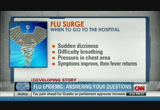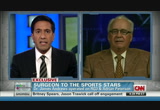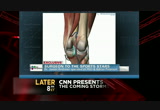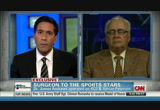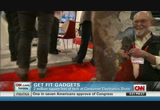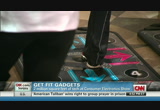tv Sanjay Gupta MD CNN January 12, 2013 1:30pm-2:00pm PST
1:30 pm
>> actually, he's a labra doodle. >> i tell people he's a labialion. >> reporter: so he can play the part of an unofficial mascot for old dominion university. in the wake of the 911 calls. >> we're not going anywhere. >> charlie has become famous. on his facebook page, getting a lion's share of likes. we would be lying if we said the color of charlie's mane is natural. he gets his man skpe tip of his tail dyed. how often does he needs maintenance to look like a lion? >> about once every four months. >> at least he's no cowardly lion, even if he does resemble the one in the wizard of oz. ♪ if i only had the nerve >> it's enough to give a dog a split personality. no wonder folks are in an uproar. charlie may not be an mgm trademark. he's already made his mark, and he's only 3. jeanne moos, cnn.
1:31 pm
>> the most friendliest laba lion you're ever going to find. >> new york. >> that's it for me. i'm martin savage. remember, you can see me on facebook all the time. cnn "newsroom" continues at the top of the hour, but first the latest on the flu epidemic. what you need to know and how to protect your family. sanjay gupta, md, starts right now. hello, and thanks for joining us today. i'm going to bust one of the biggest myths about the flu. and hopefully teach you how to protect your family from this epidemic. also, the legendary surgeon who has worked on more top athletes than just about anyone. he just operate on the redskins' quarterback, rg3. he'll be joining us. and a fitness dilemma. why you don't want to watch your weight too closely. we'll explain. ♪ by now you've heard, it's the worst flu season in years.
1:32 pm
emergency rooms in plane mayses are overflowing. at least 20 children have died. among them, a young man named max from texas. take a look at his picture. his mom said he went from being a healthy, 17-year-old to dying. in just a matter of days. it is a fast-moving story. so here's what you need to know. the flu strikes fast. and symptoms much more severe than a common cold. you feel fine one day, and then the next, a sudden fever, sore throat, headache, and tightness in the chest. >> over 200,000 people every year are hospitalized with influenza. and anywhere from 3 to nearly 50,000 people will die each year. >> flu cases are at epidemic proportions now at some areas of the country. it's the most we have seen this time of the year in a decade. >> they may get more complications from this particular h3-n2 strain, which
1:33 pm
may make them ill for a longer period of time. >> the active strain is h3-n2. it typically surfaces earlier in the season, tends to produce stronger symptoms. and it is highly contagious. in fact, when someone coughs or kne sneezes, these tiny droplets are released into the air. you can't see them with the human eye. they can live on surfaces for eight hours. say your co-worker is sick. you come over, use their key board, you've got the germs on your hand and then you touch your nose or mouth, and now you're infected. and the problem escalates if you spend several hours in tight quarters. like on an airplane. at highest risk, passengers two rows in front or behind the infected person. the best way to kill those germs is to wash your hands and do it often. and use real soap and real water. the problem is that most people don't actually wash their hands long enough. my best advice, actually sing the happy birthday song twice
1:34 pm
while you're washing your hands. that's going to be long enough. not quick to get rid of these viruses. another key to prevention is getting the flu shot. getting vaccinated. reduces your risk of getting the flu by around 60%. now another benefit to getting your flu shot is if you do get sick, your symptoms may not last as long. won't be as severe. as compared to those who weren't vaccinated. you know, we've been getting a lot of questions about the flu from you at home. i want to bring in one of my producers, ben tinker. you've been filtering through a lot of questions for us. what are you hearing? >> tons and tons of questions. first and foremost, people are wondering where they can get the vacci vaccine, saying they can't find it. a lot of people want to know if there is a shortage. >> the best way to describe it as spot shortages, a lot of doses out there, 135 million manufactured. 128 million were distributed. 112 million have been given. that means there's 16 million still out there. now it's a question of putting them in the right spot. so i think best bet is if you can't find it, your usual pharmacy, look somewhere else.
1:35 pm
>> right. a lot of people want to know, too, and these would be friends of mine, not friends of yours, who thought they could get the flu from a flu shot. and you say that's absolutely not true. >> some of my friends have asked that question as well. that is a myth. and is i think we can 'tis pens with this right now is saying that it's actually a ted virus. and an inactive virus. this is the flu shot here. you can't get it from this. but what can happen, ben, and for everybody else, once you get this shot, you're actually activating your immune system. and when you activate the immune system, that's often what makes you feel cruddy. it's not the virus itself, it's your immune system. that's not the flu. that's your body doing what it's supposed to do. sochblths when you start to feel cruddy when is the time to go to the hospital and stay on the couch, chicken noodle soup, flat jinger ale? >> all of moms advice. for most people, it's going to be exactly what you just described. you need to get rest, to let your immune system recover, drink plenty of fluids, because you can get dehydrated. take a look at the list. if you have sudden dizziness, certainly if you have it felty
1:36 pm
breathing, if you have pressure in the chest area. and this last one important as well. if your symptoms improve, you think you've beat the flu but the fever returns, that could mean you have a secondary infection. >> one last question. our viewer michael in philadelphia wanted to know, 50,000 people the cdc says can die every year. that sounds like a lot. how does it happen? how does it get to that point where it can be so dangerous, so deadly? >> let me show something that i think is really important. when you think about somebody having the flu, you're sort of counting on their immune system starting to take over. your immune cells are sort of all over your body and your bone marrow, for example. but let's say your immune system has done its job and it worked really hard to basically fight the flu. what can happen after that is you can develop secondary infections. most commonly, these secondary infections will affect the lung. known as staff low dock us. and if you look at what happened especially in young people who died from the flu. it's not the virus itself that the body has combatted but that
1:37 pm
secondary infection from a bacteria. so definitely keep those questions coming. thank you very much, ben. coming up on the show, we're going to talk to dr. james andrews. he's the surgeon to the redskins, rg3. you may remember this thing. he's a doctor who has literally treated hundreds of stars. he's going to join us next. but their shakes aren't always made for people with diabetes. that's why there's glucerna hunger smart shakes. they have carb steady, with carbs that digest slowly to help minimize blood sugar spikes. and they have six grams of sugars. with fifteen grams of protein to help manage hunger... look who's getting smart about her weight. [ male announcer ] glucerna hunger smart. a smart way to help manage hunger and diabetes.
1:38 pm
nothing. are you stealing our daughter's school supplies and taking them to work? no, i was just looking for my stapler and my... this thing. i save money by using fedex ground and buy my own supplies. that's a great idea. i'm going to go... we got clients in today. [ male announcer ] save on ground shipping at fedex office. starts with arthritis pain and a choice. take tylenol or take aleve, the #1 recommended pain reliever by orthopedic doctors. just two aleve can keep pain away all day. back to the news.
1:39 pm
it's lots of things. all waking up. connecting to the global phenomenon we call the internet of everything. ♪ it's going to be amazing. and exciting. and maybe, most remarkably, not that far away. we're going to wake the world up. and watch, with eyes wide, as it gets to work. cisco. tomorrow starts here. or treat gas with these after you get it. now that's like sunblock before or sun burn cream later. oh, somebody out there's saying, now i get it! take beano before and there'll be no gas. athletes today are able to come back strong from injuries.
1:40 pm
take adrian peterson, for example. he nearly set the nfl running record less than a year after tearing his acl ligament in his knee, and everyone has seen redskins' quarterback robert griffin iii, rg3, he also came back from a torn acl ask then went down again at the end of a playoff game. he just had an operation to fix his acl again and also his lcl ligament. dr. james andrews performed the operations on griffin and on peterson. i'll tell you, dr. andrews is far and away the star of his field. he's team dr. for the redskins, for the devil rays, football teams at auburn and university of alabama. they've done okay this season. he found time to author a new book called "any given monday." dr. andrews, a real honor to have you on the show. >> well, it's apply my pleasure to be here. >> sir, obviously you've been busy the last several days. i want to ask you a few questions about just football and sort of what you do in general. the nfl, as you know, has rolled out new sideline exams designed
1:41 pm
to keep athletes off the field if they have a concussion. i'm curious, when you think about that, is that sort of model possible for other injuries, like ankles or knees or shoulders? >> well, i think there's improvement to be done in all categories. you know, in the heat of the battle on the sidelines at an nfl game, it's sometimes tough. and professional athletes, the last ones to try to take themselves out of a football game. >> i want to show a little bit of what -- these knee ligaments for people who are curious about the anatomy here. the knee is held together by several different ligaments. the medial collateral ligament, the posterior ligament. there's about 2,000 people who injury their acl every year. half get operations, roughly. we looked at some of the data.
1:42 pm
if you're not a famous athlete, dr. andrews, can you still recover like an adrian peterson did, for example? >> well, you've got to realize that an athlete of that caliber has such tremendous genetics and ability. also has an ability to recover. and if you try to take an average sunday warrior with that same injury and try to expect the same result in that lower level athlete, then you can't really compare the two with their recovery. and i've said this often. if you operate on the right caliber athlete, they make you look pretty good as a physician. >> what do you tell people, especially parents or coaches of young players, in terms of preventing these injuries in the first place? >> the nfl now has sideline replay cameras where we can go and review retrospectively what happened. which is a new thing this year
1:43 pm
on the sidelines. which helps in the nfl. the problem with sports, though, is that the best care of an athlete is at the professional level, and the least care is at the high school and junior high school level. and our high school and junior high school kids are more vulnerable to injury. and so we're upside down with the care of athletes. these young kids really need more supervision. they need athletic trainers. that's one of the things we're working on in multiple states. there should be an athletic trainer in every public high school, because that's where minor injuries occur. and if they're recognized early by the trainers, then you can prevent minor injuries from becoming major injuries. and that's really important with any injury, particularly, as you noted, as you talked about with concussions. >> dr. james andrews, again, really appreciate you being on the show. i think a lot of people have a lot to learn from you. appreciate it, sir. >> thank you very much. it's a pleasure. i've talked a lot about the
1:44 pm
dangers of football and its big hits. last spring, former nfl linebacker junior seau, a sure hall-of-famer, he killed himself, shot himself in the chest after showing some bizarre behavior. and the question came up immediately, had he suffered brain damage from all those concussions? well now it appears he did. exams of seau's brain by the national institutes of health revealed he suffered from chronic traumatic encephalopathy, cte. it's a degenerative brain disease with alzheimer's-like symptoms. mood swings, aggression, memory loss and depression. and it happens when repeated hits to the head lead to a build-up of proteins in the brain. and you can see the difference under the microscope. the clean, white brain, a normal brain. the brown, spotted brain, a cte-impacted brain. more than 30 former professional players have been diagnosed with cte. but dr. russell lonzer who oversaw seau's examination says we still don't know how big the risk is.
1:45 pm
>> we need to understand better the incidents preference. we need to develop diagnostic tools to diagnose it, potentially, before someone passes away. we need to better understand the etiology of it so we can better manage this disorder in the future. >> but keep in mind, we hardly even talked about cte just a few years ago. there are mysterious components of it that we're going to stay on top. up next, how to avoid diet pitfalls with real science. coming back with dr. robert lustig right after this. i'm up next, but now i'm singing the heartburn blues. hold on, prilosec isn't for fast relief. cue up alka-seltzer. it stops heartburn fast. ♪ oh what a relief it is!
1:48 pm
over the last few months, you've probably heard me talk a lot about the importance of limiting sugar in your diet. and a lot of that knowledge is based upon the work of dr. robert lustig. oo he's the author of this new book called "fat chance." you're not talking about just adding to your waistline or
1:49 pm
pounds to your body. you're talking about something in the way that these substances behave in the body. >> that's right. we're not talking about pounds. i think that the worst thing you can do is get on the scale. when you get on the scale, you're measuring four compartments at once. bone, more is better. muscle. more is better. subcutaneous or big butt fat, if you will. more is better. in fact, people with larger amounts of subcutaneous fat have longevity. and belly fat. more is worse. but that's only 4% of your total body weight. so when you stand on a scale, what are you measuring, you can't know. so it's not about weight, it's about waste. that tells you where the metabolic dysfunction is. the problem is, there are a lot of people out there who are normal weight who have that same metabolic dysfunction as the obese to, they just don't know it. 40% of normal weight people have metabolic dysfunction. they are as in this issue as the
1:50 pm
obese are. >> we see, they call it skinny fat, i see, right, people who look skinny but then they have large wastes. >> not even just large waists. they can have normal waists. jimmy bell, a neuro imageer at cambridge, university of college london calls it tofi, t-o-f-i. thin on the outside, fat on the inside. when you do mris inside, you can actually see the fat in all of the organs. the muscle, the heart, et cetera. bottom line is, from your weight, you can't tell where you are. >> so how -- so what do you do? how can you tell, first of all? >> well, in fact, the best way is, again, waist circumference. that's the cheapest way. there are some lab tests your doctor can do, a fasting insulin and some liver function tests that can give you clues as to whether or not there is a problem or not. but the single best way to deal with excess fat is to get it off and the easiest way to do that is to exercise. the problem with exercise is, every doctor will tell you, if you exercise, you would lose
1:51 pm
weight. that's because they say a calorie is a calorie. so if you burn them off, you would lose weight. guess what, there is not one scientific study, not one literature reference that you can point to that says that exercise causes weight loss. what it does is, it causes muscle gain. and muscle has mitochondria, the energy-burning factories inside cells. and so therefore, you're not going to turn it into liver fat, you're not going to turn it into muscle fat. you're going to burn it instead, and you're going to be healthier. >> exercise sort of refs up the engine, so what you eat you maybe burn more effectively rather than storing as fat. >> basically, when you eat something, it has one of three fates. you can burn it, that's the best. you can store it, that's not so good. or it can go out in your urine, and that's called type 2 diabetes and that will kill you. which would you rather have it? >> we try to give you advice that's really based in science here. and dr. robert lustig has a lot to say, here about sugar.
1:52 pm
this month i also got to visit the consumer electronics show in las vegas. 2 million square feet of nothing but gadgets. some great ideas out there to make us healthier and a few things that are just kind of cool. ♪ >> so what are we looking at here? >> so what we have is the puzzle box orbit. this is a brain controlled helicopter. so if i stop talking for a second, and i actually concentrate on the bar, i'll make the helicopter fly. just like that. >> so we're just looking at my brain waves between 12 and 20 hertz. if we see brain waves between that range, that's going to trigger the helicopter. ♪
1:53 pm
>> this looks decidedly low-tech. hard to believe this is here at a consumer electronics show, but it's the back end over here where you actually see all the technology. what are we looking at here? >> we're looking at a fork that's designed to help you eat more slowly. every time i put food to my mouth, it triggers a timer. in this case, we have a ten-second timer. if i put more food in my mouth in under ten seconds, let's say nine seconds, it will vibrate very gently, thanks to a -- the tip of the fork. you see, you're getting just a gentle -- we don't want to electrocute anybody. it's just a very, very mild vibration. ♪ the thing about an insurance company helping sponsor something like "dance dance revolution" how does that come about? >> part of our job is to make sure that people live healthier lives but also combat the costs of the health care in the united
1:54 pm
states. and we know that preventable disease is the number-one cost driver. if we can beat childhood obesity, create healthier adults, that will lower costs for everything. ♪ >> you know, we gently know to exercise and to take care of our diet. sometimes the technology can help, as well. as you saw there. still ahead, a former emergency room physician is now warning us to slow down. that's his warning. seems like we're all plugged in 24/7. he's going to make the case for going full throttle. but doing it 24/6. hey! did you know that honey nut cheerios
1:56 pm
1:57 pm
imagine a 15-year-old girl being told by her doctor she might not even live another week because of something she was doing to her own body. chelsea roff was that girl, and she was slowly killing herself. but the old adage applies here. what doesn't kill you can make you stronger. >> how are you? >> when you see chelsea roff now looking happy and vibrant, it's
1:58 pm
nearly impossible to imagine the day she says a part of her brain died. at just 15 years old, roth had suffered a stroke. brought on by severe anorexia. >> i now know from looking at hospital records that i was 58 pounds. >> 58 pounds. and close to dying. because so many parts of her body were failing. there are no pictures of roth at her sickest. this picture is from about a year earlier when she was in and out of treatment centers. but she remembers how starting a diet with her mom in the midst of a difficult and sometimes dangerous childhood spiraled into a disorder that nearly killed her. >> looking back, i think my body was my only way to tell the people around me that something wasn't okay. and that i was scared and that i was hurting and that i needed help. >> help came for roff when she was hospitalized for 18 months following her stroke. >> i had a bed, i had nurses and doctors that showed up every day and were consistent, and i had food, and i had water, and i was
1:59 pm
finally getting, like, digestive function back. >> as part of her recovery, her therapist suggested roff try yoga, to try listening to her body again without burning too many calories. and almost immediately, she was hooked. >> before i knew it, i had gained 20 or 30 pounds and had done a yoga teacher training and was teaching yoga at a juvenile detention center. and it became sort of a love affair for me. my name is chelsea. i am a patient. >> today she writers and shares her story with other patients who struggle with eating disorders, as well as her loved ones. >> i tell these girls that i am not afraid of my fullness. >> she is quick to point out that yoga is not a cure for anything. it's one of only many tools that when used correctly, helped her rebuild her life. >> you can live in your body fully. you can have happiness. and that's for me, the biggest thing. >> eating dor
201 Views
Uploaded by TV Archive on

 Live Music Archive
Live Music Archive Librivox Free Audio
Librivox Free Audio Metropolitan Museum
Metropolitan Museum Cleveland Museum of Art
Cleveland Museum of Art Internet Arcade
Internet Arcade Console Living Room
Console Living Room Books to Borrow
Books to Borrow Open Library
Open Library TV News
TV News Understanding 9/11
Understanding 9/11





